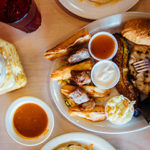 1. Get an accurate head count.
1. Get an accurate head count.
This is key when it comes to homing in on the amount of food you’ll really need for your event.
2. Communicate early and often with your catering staff — and rely on their expertise.
More than anyone, chefs know how much people eat, and have put hard work and thought into planning menus that are both delicious and draw on bulk items. Just work out those menus long before an event. “Finalize your menus at least 30 days ahead of time,” said Scott Donley, assistant executive chef at The Venetian | The Palazzo Resort Hotel & Casino in Las Vegas.
3. Ask your caterer to order in bulk whenever possible.
Also ask if they can use less-than-perfect produce in salads and sandwiches. This reduces packaging waste, and also draws on a wider range of produce. “Also,” said MeetGreen’s Shawna McKinley, “look at a style of service that eliminates packaging.”
4. Discourage pre-pours and automatic glass refreshes.
How many half-drunk glasses of water and soda did you see servers clear away at your last event?
5. Consider plated or concession meals, rather than buffet-style service.
Buffets are where the majority of food waste occurs at meetings and events.
6. If you do opt for a buffet, loosen your refresh rules.
Wait for a tray to be empty before replenishing it — and consider letting it go empty for good toward the end of a program.
7. Hold some food back from a buffet or spread.
Have kitchen staff keep that food safe, so if it’s not needed it can be donated. “We need to think, what can we salvage?” said independent meeting professional Sandra Wood, CMP. “What can we recover from this event and get it back into the community?”
8. Communicate your benchmarks to attendees.
At IMEX America, digital signage tells attendees how much waste they’re generating and where that waste goes after the event. It joins the organization and its attendees in a goal that makes everyone feel good.




